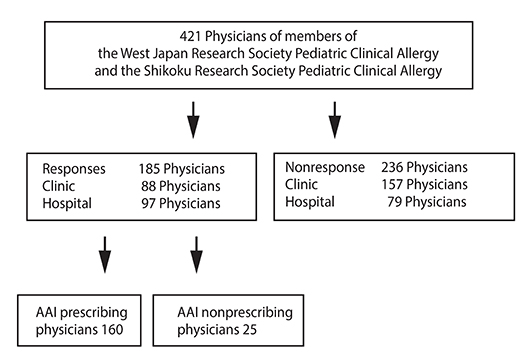Asia Pac Allergy.
2017 Jan;7(1):37-41. 10.5415/apallergy.2017.7.1.37.
Administration of the adrenaline auto-injector at the nursery/kindergarten/school in Western Japan
- Affiliations
-
- 1West Japan Research Society Pediatric Clinical Allergy, Fukuoka 811-1394, Japan. kseigo@oita-u.ac.jp
- 2Oita University Faculty of Medicine, Oita 879-5593, Japan.
- KMID: 2396912
- DOI: http://doi.org/10.5415/apallergy.2017.7.1.37
Abstract
- BACKGROUND
In view of the increasing prevalence of food allergies, there has been an associated increase in frequency of situations requiring an emergency response for anaphylaxis at the home, childcare facilities and educational institutions.
OBJECTIVE
To clarify the situation of adrenaline auto-injector administration in nursery/kindergarten/school, we carried out a questionnaire survey on pediatric physicians in Western Japan.
METHODS
In 2015, self-reported questionnaires were mailed to 421 physicians who are members of the West Japan Research Society Pediatric Clinical Allergy and Shikoku Research Society Pediatric Clinical Allergy.
RESULTS
The response rate was 44% (185 physicians) where 160 physicians had a prescription registration for the adrenaline auto-injector. In the past year, 1,330 patients were prescribed the adrenaline auto-injector where 83 patients (6% of the prescribed patients) actually administered the adrenaline auto-injector, of which 14 patients (17% of the administered patients) self-administered the adrenaline auto-injector. "Guardians" at the nursery/kindergarten and elementary school were found to have administered the adrenaline auto-injector the most. Among 117 adrenaline auto-injector prescription-registered physicians, 79% had experienced nonadministration of adrenaline auto-injector at nursery/kindergarten/school when anaphylaxis has occurred. The most frequent reason cited for not administering the adrenaline auto-injector was "hesitation about the timing of administration."
CONCLUSION
If the adrenaline auto-injector was administered after the guardian arrived at the nursery/kindergarten/school, it may lead to delayed treatment of anaphylaxis in which symptoms develop in minutes. Education and cooperation among physicians and nursery/kindergarten/school staff will reduce the number of children suffering unfortunate outcomes due to anaphylaxis.
Keyword
MeSH Terms
Figure
Cited by 2 articles
-
The 10th Anniversary of Asia Pacific Allergy
Yoon-Seok Chang
Asia Pac Allergy. 2020;10(1):. doi: 10.5415/apallergy.2020.10.e10.Asia Pacific allergy: 6 years old
Yoon-Seok Chang
Asia Pac Allergy. 2017;7(1):1-2. doi: 10.5415/apallergy.2017.7.1.1.
Reference
-
1. Grabenhenrich LB, Dölle S, Moneret-Vautrin A, Köhli A, Lange L, Spindler T, Ruëff F, Nemat K, Maris I, Roumpedaki E, Scherer K, Ott H, Reese T, Mustakov T, Lang R, Fernandez-Rivas M, Kowalski ML, Bilò MB, Hourihane JO, Papadopoulos NG, Beyer K, Muraro A, Worm M. Anaphylaxis in children and adolescents: The European Anaphylaxis Registry. J Allergy Clin Immunol. 2016; 137:1128–1137.e1.
Article2. Ward CE, Greenhawt MJ. Treatment of allergic reactions and quality of life among caregivers of food-allergic children. Ann Allergy Asthma Immunol. 2015; 114:312–318.e2.
Article3. Rhim GS, McMorris MS. School readiness for children with food allergies. Ann Allergy Asthma Immunol. 2001; 86:172–176.
Article4. Simons FE, Ebisawa M, Sanchez-Borges M, Thong BY, Worm M, Tanno LK, Lockey RF, El-Gamal YM, Brown SG, Park HS, Sheikh A. 2015 update of the evidence base: World Allergy Organization anaphylaxis guidelines. World Allergy Organ J. 2015; 8:32.
Article5. Pistiner M, Devore CD, Schoessler S. School Food Allergy and Anaphylaxis Management for the Pediatrician--Extending the Medical Home with Critical Collaborations. Pediatr Clin North Am. 2015; 62:1425–1439.
Article6. Urisu A, Ebisawa M, Ito K, Aihara Y, Ito S, Mayumi M, Kohno Y, Kondo N. Committee for Japanese Pediatric Guideline for Food Allergy. Japanese Society of Pediatric Allergy and Clinical Immunology. Japanese Society of Allergology. Japanese guideline for food allergy 2014. Allergol Int. 2014; 63:399–419.
Article7. Inoue N, Yamamoto A. Clinical evaluation of pediatric anaphylaxis and the necessity for multiple doses of epinephrine. Asia Pac Allergy. 2013; 3:106–114.
Article8. Fleming JT, Clark S, Camargo CA Jr, Rudders SA. Early treatment of food-induced anaphylaxis with epinephrine is associated with a lower risk of hospitalization. J Allergy Clin Immunol Pract. 2015; 3:57–62.
Article9. Vale S, Smith J, Said M, Mullins RJ, Loh R. ASCIA guidelines for prevention of anaphylaxis in schools, pre-schools and childcare: 2015 update. J Paediatr Child Health. 2015; 51:949–954.
Article10. Caffarelli C, Coscia A, Ridolo E, Povesi Dascola C, Gelmett C, Raggi V, Volta E, Vanell M, Dall'Aglio PP. Parents' estimate of food allergy prevalence and management in Italian school-aged children. Pediatr Int. 2011; 53:505–510.
Article11. Fleischer DM, Perry TT, Atkins D, Wood RA, Burks AW, Jones SM, Henning AK, Stablein D, Sampson HA, Sicherer SH. Allergic reactions to foods in preschool-aged children in a prospective observational food allergy study. Pediatrics. 2012; 130:e25–e32.
Article12. Ben-Shoshan M, Kagan R, Primeau MN, Alizadehfar R, Verreault N, Yu JW, Nicolas N, Joseph L, Turnbull E, Dufresne C, St Pierre Y, Clarke A. Availability of the epinephrine autoinjector at school in children with peanut allergy. Ann Allergy Asthma Immunol. 2008; 100:570–575.
Article
- Full Text Links
- Actions
-
Cited
- CITED
-
- Close
- Share
- Similar articles
-
- Adrenaline dilution in dental local anesthesia for patients with underlying disease
- Adrenaline dilution in dental local anesthetic: a preliminary study to prevent coring in cartridges
- Microsporum canis Infections in a Group of Nursery School Children
- Pediatric anaphylaxis at a university hospital including the rate of prescribing epinephrine auto-injectors
- A Study on Nursery School Teacher's Knowledge and Education of Nutrition Care in Gwang-Ju


